Good Vibrations
Dennis Beach ’91 transforms plywood, epoxy, and paint into geometric sculptures, paintings, and kinetic designs that echo natural forms and phenomena.
His sculpture, “Drift #24,” for example, evokes sound waves or ocean waves in its symmetrical undulations. “Flow,” a kinetic sculpture, suspended above gallery-goers, features moving water inside a tubular acrylic pipe. “Bump #4,” a 96-inch-long wall-mounted piece, might resemble a dinosaur spine or modernized sand dunes. In each piece, Beach’s interpretations express his affinity for nature and engineering.
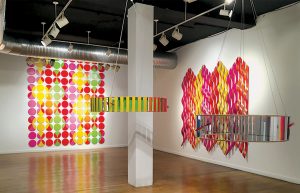
Beach’s work in a solo exhibition at School 33 Art Center in Baltimore (2016). Back (left): “Pop,” acrylic on plywood; Back (right): “Drift #24,” plywood, acrylic, and epoxy. Center: “Spins #2”; Front (right): “Spins #3.” Both hanging sculptures are suspended by steel cables and use photovoltaic motors to rotate. Photo courtesy of Joyce Jewell.
Beach’s work has exhibited in solo shows and been installed in permanent collections throughout the mid-Atlantic: in Philadelphia, New York, Delaware, Baltimore, and Washing-ton, DC,—all places where the artist has lived, worked, trained, and been inspired. In 2016, he exhibited at the King Street Gallery on the Takoma Park/Silver Spring Campus, invited by his former professors/mentors Joyce Jewell and Wil Brunner.
In his Wilmington, Delaware, studio, Beach works from sketches to develop his large 3D works, often in series that explore themes and repetition. For the former US Navy mechanical engineer, fitting geometric shapes together into a cohesive contemplative design is work that satisfies his affinity for machinery in general.
“I really like putting things together in new ways,” Beach says. “Every time I make something, I experiment by taking a simple shape and repeating it over and over. I make a decision to cut the wood a certain way, but the works evolve from each other. For series, I build it first—deciding how big, how round, how curved and then the next time, I go bigger, longer, and curved differently.”
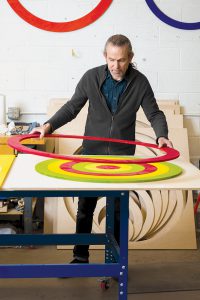
Beach in his Delaware studio placing concentric rings in a new work designed to be walked on.
Beach’s geometric abstractions begin as sketches. To build the sculptures, he layers the wood pieces and laminates them using pigmented epoxy, which is left exposed as a design element. He makes precise cuts from high-quality plywood. Experimenting with shapes, he often finds use for scraps from previous projects. When the build is complete, he sands it to a smooth finish. Then, he does a test assembly before taking it apart to paint. His sculpting process can take anywhere from a few months to more than a year to complete.
Beach paints in saturated tones that create a visual vibration when placed side by side with their color complements. Red on green, blue on yellow, bubble-gum pink on neon green energize pieces already suggesting movements in their undulations and repetitions.
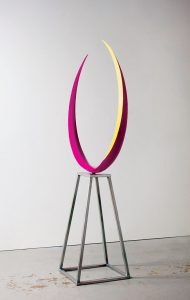
“Wedge #4,” plywood and acrylic.
Concerning scale, Beach says, “bigger is more exciting.” He built a floor sculpture, “Curve,” that runs 24 feet long and stands 8 feet tall. “Twist 1” and “Twist 2” are each 8 feet tall. He builds large works as modular pieces so they can be transported and re-assembled on site. “Aesthetically, I like the spaces between the modular parts to be obvious,” he says.
Beach has an upcoming show this fall at Schmidt Dean Gallery in Philadelphia, as well as a show early next year in Wilmington to coincide with the 2018 Established Fellowship in the Visual Arts: Sculpture Discipline that he recently received from the Delaware Division of the Arts. He has been working on new pieces for both shows, as well as finishing up a large commission. “I am excited about a new floor piece that will be about 16 feet by 16 feet that you will be able to walk on,” Beach says. “That should make for a new way to experience my art.”
Dennis Beach earned a BFA from Maryland Institute College of Art and an MFA from University of Delaware.
—Diane Bosser
Photography by Daniel Jackson and Joyce Jewell

“Wave #2,” plywood and acrylic, 18″ x 114″ x 2″.
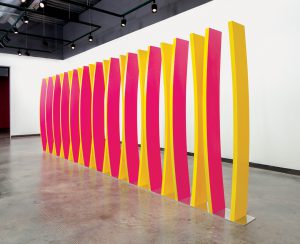
“Curve,” plywood, acrylic, and epoxy, 8′ x 24′ x 2′.
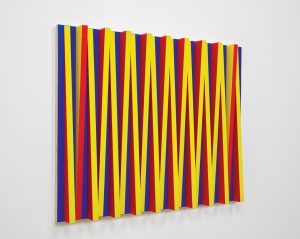
“Wedge #4,” plywood and acrylic.



